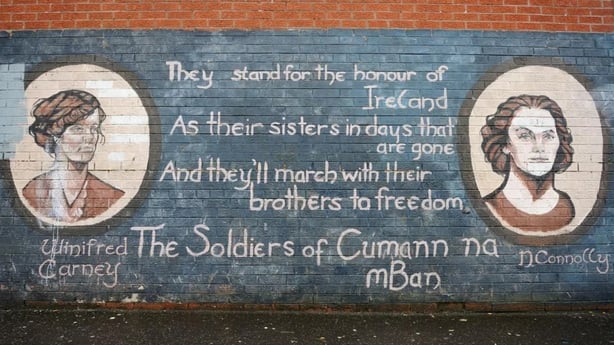Analysis: The statues of Mary Ann McCracken and Winifred Carney will go some way to addressing the underrepresention of women in monuments
By Sophie Doherty, Open University
Yesterday on International Women's Day, Belfast City Council unveiled statues of social justice activists Mary Ann McCracken and Winifred Carney. Statues are a valuable part of our visual history, recording narratives and values and commemorating those who have helped to shape the past, present and future. Unfortunately, however, women are significantly underrepresented in monumental works.
Societies are built on the lives, triumphs, and failures, of both men and women and this should be acknowledged in visual culture. The statues of McCracken and Carney will commemorate, and testify to the significance and contribution of women towards a more socially just society in Ireland and beyond.
In 2022, Belfast City Council issued a call for artists to help design the statues of the two women, explaining that McCracken and Carney are "key figures in Belfast's history" and "it is fitting that they will be permanently remembered through statues alongside other notable figures from the city's past in the front lawn areas of City Hall". So who were these social justice activists and what did they do?
We need your consent to load this rte-player contentWe use rte-player to manage extra content that can set cookies on your device and collect data about your activity. Please review their details and accept them to load the content.Manage Preferences
From RTÉ Archives, Morning Ireland report from August 1987 on a musical staged in Sligo about remembering and celebrating Mary Ann McCracken
Mary Ann McCracken was born in Belfast on July 8th 1770. From an early age, she was 'intensely interested in politics and various political incidents, in which some of her relatives were concerned'. Throughout her life, she championed various social justice causes, such as women's’ rights, better treatment of the poor, and to end slavery.
McCracken was involved with organisations such as the Poor House Ladies Committee, where she helped children learn domestic skills while also advocating for access to education. She also founded the Belfast Women's Anti-Slavery League, a body set up after Frederick Douglass' visit to the city in 1846.
Speaking about McCracken's 'undeserved obscurity’, Professor David Olusoga commented that this could partly be ‘because of gender but also the "historical disappearance" of abolitionists after emancipation in 1834’. Furthermore, the Belfast Charitable Society note that ‘her legacy is overshadowed by her brother, Henry Joy McCracken – the executed United Irishman – despite outliving him by 68 years.’
Maria Winifred Carney was born on December 4th 1887 in Bangor and is most known for her role as 'aide-de-camp' to James Connolly. She is recorded as being the first woman to enter the GPO in Dublin during the Easter Rising in 1916, reportedly armed with a typewriter and a Webley pistol. In addition to her fight for Irish independence, Carney was involved in both the suffragette movement andtrade union movement, co-writing the 1913 manifesto of the Irish Textile Workers' Union with Connolly.
We need your consent to load this rte-player contentWe use rte-player to manage extra content that can set cookies on your device and collect data about your activity. Please review their details and accept them to load the content.Manage Preferences
From RTÉ's Women of the 1916 Rising, Julia Grenan recalls staying in the GPO in Easter 1916 along with Elizabeth O'Farrell and Winifred Carney after being ordered to leave by Patrick Pearse
Carney's relative obscurity could, in part, be attributed to her gender and the legacy. A major issue that characterises discussions on statues like these is the issue of representation. In her famous 1975 essay 'Why have there been no great women artists?, art historian Linda Nochlin says that 'the so-called woman question, far from being a minor, peripheral, and laughably provincial sub-issue grafted on to a serious, established discipline, can become a catalyst, an intellectual instrument, probing basic and "natural' assumptions.'
Questioning the relative absence of women in relation to monuments in Ireland becomes a political, cultural, institutional and feminist question. Writing in the Irish Times, art historian Paula Murphy made the point that the "widespread refrain around public sculpture points to an absence of women – or at least to the fact that there is insufficient representation of women – among the figurative images in Irish public spaces, where statues of men predominate."

A 2022 Art UK study on the digitisation of monuments highlighted that just 17% of public sculptures in the UK are dedicated to named women. This underrepresentation is also evidenced in the United States, where just 6% of statues are of real women. This produces a valid question on why women are underrepresented in monuments and statues in a global context.
It is important to include women such as McCracken and Carney in the visual history and culture of society so that their achievements and lives can be showcased. It highlights the women who have advanced social justice on the island of Ireland and beyond.
But, to quote Equality Now's Jacqui Hunt, "a statue cannot be merely a tokenistic gesture or hollow substitute for tangible advancements in gender equality. This includes recognising women's abilities and achievements alongside true equality in areas such as career progression, equal pay, shared childcare and other forms of support so that all women and girls can reach their full potential." A sentiment that would undoubtedly be echoed by both McCracken and Carney.
Follow the RTÉ Brainstorm WhatsApp channel for more stories and updates
Dr Sophie Doherty is a Lecturer in Law at the Open University and co-founder of OU Law and Humanities Research Cluster.
The views expressed here are those of the author and do not represent or reflect the views of RTÉ

